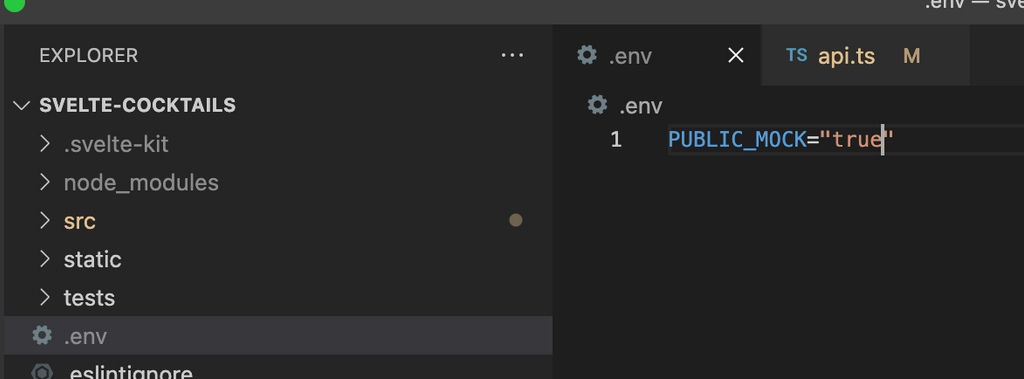Recently I was travelling and I wanted to spend some time working on my wonderful Svelte Cocktail app while on the train. Since I would have a bad internet connection I wanted to be able to use mocked API responses instead of real ones.
I had a function that returned ingredients from the API, and within this I added a mocked response with the right response type and commented out the real code. All good:
export const getIngredients = async (): Promise<Ingredient[] | null> => {
const ingredientsResponse = await getMockIngredients();
const ingredientsObject = JSON.parse(ingredientsResponse);
return ingredientsObject;
// try {
// console.log("Getting ingredients");
// const ingredientsResponse = await fetch(
// "https://www.thecocktaildb.com/api/json/v1/1/list.php?i=list"
// );
// const ingredientsObject = await ingredientsResponse.json();
// return ingredientsObject.drinks;
// } catch (error) {
// throw new Error("Error getting ingredients list");
// }
};However, it’s annoying to have to shift code about and comment/uncomment things as I go back to a normal internet connection. To make things more convenient I wanted to set the ‘mode’ I was in when starting the app. To do this I used environmental variables with Sveltekit, and it turn’s out it’s very easy to do. Here’s how:
Creating a .env file
The first step for declaring environmental variables in a Svelte app is to use a .env in the root of the project. Doing this is supported out of the box with Vite (the tooling that starts a Svelte app server).
If we look at the Sveltekit modules docs, we can see that there are various options for setting Vite environmental variables. Usually the client code can’t read environmental variables to prevent sensitive data to the user. However In my case I wanted the client app to be able to read this variable, so I made sure that the variable begins with PUBLIC_. It looks like this:

Setting up the API to read the environmental variable
Now we can read the environmental variable. To check it’s working, I added a console.log in the first line of the getIngredients to make sure it’s picked up. Before that I had to import the environmental variable using the $env.static.public package from Vite. This allows the app to read any variables declared with PUBLIC_ at the start of them.
import { PUBLIC_MOCK } from '$env/static/public'; // import this line!
export const getIngredients = async (): Promise<Ingredient[] | null> => {
console.log('ENV VAR: ', PUBLIC_MOCK); // checking the variable can be read.
// rest of function...This function runs when the app starts, so I can check the console to see it’s been picked up.

Logic
Now I just need to add some logic to import the mocked response if PUBLIC_MOCK is set to true:
import type { Ingredient, Cocktail } from "../types/types";
import {
getMockIngredients,
getMockCocktails,
} from "../../tests/utils/mockResponses";
import { PUBLIC_MOCK } from "$env/static/public";
export const getIngredients = async (): Promise<Ingredient[] | null> => {
if (PUBLIC_MOCK === "true") {
const ingredientsResponse = await getMockIngredients();
const ingredientsObject = JSON.parse(ingredientsResponse);
return ingredientsObject;
}
try {
console.log("Getting ingredients");
const ingredientsResponse = await fetch(
"https://www.thecocktaildb.com/api/json/v1/1/list.php?i=list"
);
const ingredientsObject = await ingredientsResponse.json();
return ingredientsObject.drinks;
} catch (error) {
throw new Error("Error getting ingredients list");
}
};Now I can set PUBLIC_MOCK to false in the .env file and the API will try to fetch a response from the real API.